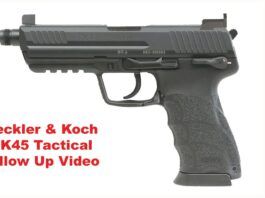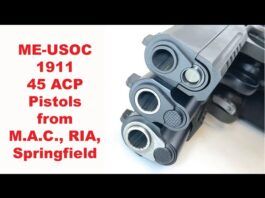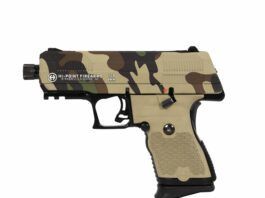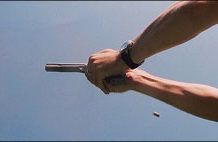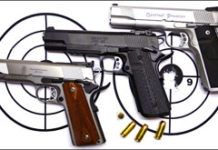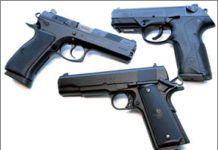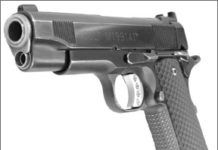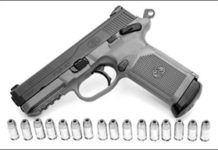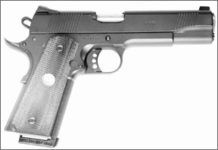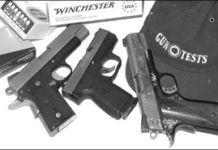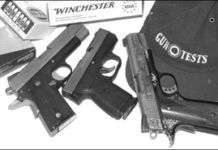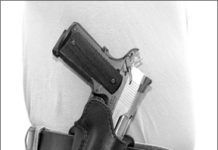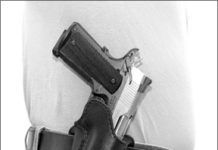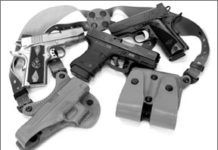Wild Bunch Pistols: Colt 1918 Leads The Pack, But At A Price!
Fine Factory 1911s: S&W, STI, Springfield Armory Battle
Affordable 45s: Para USA, CZ, and Beretta Shoot It Out
When it comes to 45 ACP semi-automatics, we're always looking for ways to fill our holsters without emptying our bank accounts. There are many 45s that cost about $1200, and it's not hard to find 45s that cost twice that or more. In this test we will look at three affordable 45s with suggested retail prices that are well under the $1000 mark. Aside from categorizing by price, both the $650 Beretta PX4 Storm F and the $874 CZ 97BD could also be categorized as traditional double action (TDA) guns. We compared these guns to a $600 single-action 1911, the new Para USA GI Expert.
We followed the same test procedure as our last evaluation of 45 ACP pistols published in the April 2009 issue. We fired five-shot groups from a bench at targets 15 yards downrange. Then, we put our guns through an action test of firing 10 three-shot strings standing offhand at an IPSC Metric target 7 yards away. Using a shot-activated electronic timer, we began with the pistol held chest high with both hands. Upon an audible start signal, we pushed the gun toward the target and attempted to land two hits inside the 5.9-inch-wide by 11.1-inch-high A-zone located at center mass, followed by a single shot to the B-zone, which delineated the head area of our target. This area was 6.4 inches by 6.9 inches. We've used this procedure many times before and think it offers valuable insight into what is required to bring the gun into action. We shot this test at the Impact Zone in Monaville, Texas (theimpactzonerange.com).
What proved more difficult than formulating a test procedure was finding ammunition. Supplies of popular calibers such as 45 ACP have all but dried up. If we hadn't visited Top Gun in Houston (topgunrange.com), we may not have been able to find any reasonably priced ammunition at all. To test we purchased a supply of Hornady 200-grain XTP hollowpoints for about $22 per 20-round box. We handloaded two other test rounds. They consisted of cases topped with Zero brand 185-grain jacketed hollowpoints and 200-grain roundnosed lead bullets by Bushwacker. Each round was powered by Winchester 231 powder with charges about midway between the starting load and the maximum load, as per Hodgdon's latest load data. We used Winchester large pistol primers, and the rounds were loaded on a Dillon Precision Super 1050. Both our handloads were previously developed for competition, so we knew our rounds would be safe and accurate. Throughout our tests, all three guns performed without malfunction, so we were able to concentrate on the handling and performance of each pistol. Here is what we found in our side-by-side evaluations:
High-End 45 ACP Follow-Up: Michiguns Commander Custom
High-End 45 ACP Follow-Up: Michiguns Commander Custom
Double-Column 45 ACPs: CZ, H&K, and FN Shoot It Out
Terrific Trio of Custom 45s: Volkmann, Wilson, Les Baer
If you have over two grand to put into a good 45 auto, which one will you get? For that kind of money you can pretty much tell a custom builder what you want and expect to get it, can't you? Not quite, as it turns out. Or can you be satisfied with a fairly standard, if costly, over-the-counter 1911? We decided to take a look at some of the higher-priced 45s to see what gives. The test guns were full-size 1911s in 45 ACP caliber. We obtained a pistol called the Combat Custom ($2895 as tested) from a relatively new maker, Luke Volkmann of Volkmann Custom Inc., who will give you pretty much what you want for options, which we pitted against Wilson's CQB ($2550) and Les Baer's Premier II Super-Tac ($2280).
Attempting to pick the best one out of all these very fine handguns was anything but easy. They are all excellent, with fine triggers, great accuracy, and many touches that set them apart from the ordinary. In light of the ongoing national surge to buy all kinds of firearms, especially those designed for self defense, you may have a hard time finding one of these better-grade 1911s.
We shot the guns for accuracy and function, and evaluated them for self-defense training and general use. These were all outstanding pistols, yet we found some anomalies that might help you pick and choose. We tested with four types of ammunition, Black Hills' hardball, Federal 185-grain Hi-Shok JHP, Cor-Bon 230-grain JHP, and with cast-lead, 230-grain round-nose Ultramax. We tested during a severe winter in Idaho, and thus had trouble achieving these guns' full accuracy potential. Better conditions would have given better results, but the conditions were the same for all guns and thus valid for reference. They are hardly what you'd call lousy. Also, we shot two other known handguns every now and then during these tests to make sure we were not too far off base. Here is what we found.
Three Small 45 Autos: The New SIG Sauer 1911 C3 Is Superior
An the opinion of many experienced shooters, the 45 Auto is the caliber of choice in self-defensive pistols. However, most of these guns, like the classic 1911 Colt, are big and heavy. Therefore, they often get left behind for a lighter piece, which generally is of lower power. If you still want the power of a 45, why not go to a smaller and lighter gun?
We found three such pistols for this test, and gave them a wring-out. They were a Colt CCO, no longer in the Colt stable but available on the used or new-old-service market for about $1250, depending on condition; the recently introduced SIG Sauer 1911 C3 No. 19GS0031, $1143; and a new PM45-series pistol from Kahr, the PM4543, $855. The Kahr was not quite the same setup but clearly had the same intent as the other two, to deliver big power in a smaller, lighter package.
Both the SIG and Colt had aluminum frames, and they featured the old Colt Officer's Model handle with the Commander-length slide. Most of our test group believes this is the ideal setup for a 1911-type 45 auto, but those with large, wide hands might prefer a gun like the lightweight Commander, which has a bigger grip. The Kahr had its usual ergonomically designed polymer grip with stainless slide, and of course was DAO. We tested with three types of ammunition, Federal 185-grain Hi-Shok JHP, Federal 230-grain ball, and with Cor-Bon 185-grain JHP. We also tried a few groups with Federal Gold-Medal Match, 185-grain TC bullets. Here's what we found.
Three Small 45 Autos: The New SIG Sauer 1911 C3 Is Superior
An the opinion of many experienced shooters, the 45 Auto is the caliber of choice in self-defensive pistols. However, most of these guns, like the classic 1911 Colt, are big and heavy. Therefore, they often get left behind for a lighter piece, which generally is of lower power. If you still want the power of a 45, why not go to a smaller and lighter gun?
We found three such pistols for this test, and gave them a wring-out. They were a Colt CCO, no longer in the Colt stable but available on the used or new-old-service market for about $1250, depending on condition; the recently introduced SIG Sauer 1911 C3 No. 19GS0031, $1143; and a new PM45-series pistol from Kahr, the PM4543, $855. The Kahr was not quite the same setup but clearly had the same intent as the other two, to deliver big power in a smaller, lighter package.
Both the SIG and Colt had aluminum frames, and they featured the old Colt Officer's Model handle with the Commander-length slide. Most of our test group believes this is the ideal setup for a 1911-type 45 auto, but those with large, wide hands might prefer a gun like the lightweight Commander, which has a bigger grip. The Kahr had its usual ergonomically designed polymer grip with stainless slide, and of course was DAO. We tested with three types of ammunition, Federal 185-grain Hi-Shok JHP, Federal 230-grain ball, and with Cor-Bon 185-grain JHP. We also tried a few groups with Federal Gold-Medal Match, 185-grain TC bullets. Here's what we found.
Mixed Bag in Self Defense: Partner Handguns Fight It Out
Mixed Bag in Self Defense: Partner Handguns Fight It Out
Subcompact 45 ACPs: Glocks G30SF Makes It Look Easy
In this evaluation of 45 ACP subcompacts, we're going to ask how best to package the big bullet in a small concealable machine. We could say that our three test guns represent two-and-a-half interpretations of the subcompact pistol. That's because our first two pistols, Kimber's $1316 SIS Ultra and Springfield Armory's $1031 Loaded Ultra Compact, are both small single-stack 1911s. But there are differences that set them apart. The third gun feeds from a high-capacity magazine with rounds compressed in a staggered column. Furthermore, ignition is via a striker system, and the frame is polymer, not steel. This is the $687 Glock G30SF. If the price of the G30SF seems steep, that is because we ordered the gun with options such as night sights that added cost—but with the price of the Kimber and Springfield Armory pistols north of $1000, we had room to play around. Ultimately, we had a good representation of each manufacturer's smallest high-end 45.
Testing small guns is generally more challenging than testing full-size models. Big-frame guns may offer more than one suitable hand position. A small gun usually offers one grip position, like it or not. Consider the shorter sight radius. A 3-inch pistol may steer quicker than a 6-inch-barreled revolver, but any twitch of the little gun's front sight likely means the shooter will overcorrect.
Our first measure of accuracy was from sandbag support at 15 yards. With little framework to support these guns, our task was more difficult than mounting 5-inch-barrel Government models with longer dustcovers. Plus, a shorter slide means that its travel from battery to fully open provides less time to evacuate and recharge the chamber. We had to be careful not to let the slide touch any part of our support. This could slow the movement of the slide and cause a malfunction.
Our test ammunition was led by two defense rounds. They were Winchester's 185-grain Silvertip HP (hollowpoint) rounds and Federal's 165-grain expanding full metal jacket low-recoil ammunition. This round resembled a truncated cone (a triangle with the point cut off). With the price of ammunition soaring, we had intended to handload our practice ammunition. But we found that a 100-count box of quality jacketed bullets cost about the same as a 100-round box of loaded Winchester 230-grain FMJ ammunition purchased from Wal-Mart.
Loading lead bullets would have saved us money, but the polygonal barrel of the Glock, which once leaded greatly effects accuracy and is difficult to clean, repelled us from that option. We used the 230-grain ammunition in our action test, which consisted of standing and shooting a rapidfire string of seven continuous shots. Our target was the 4-inch bull of an 8.5-inch by 11-inch Caldwell paper target mounted 15 yards downrange.
Seven shots was the common denominator in terms of capacity between our three pistols, so we decided to count how many shots out of seven we could land on the notebook sized paper. This test was performed cold, picking up the gun and performing the drill one time only. Reliability, accuracy, ease of operation and concealment were our primary concerns in this test.





























